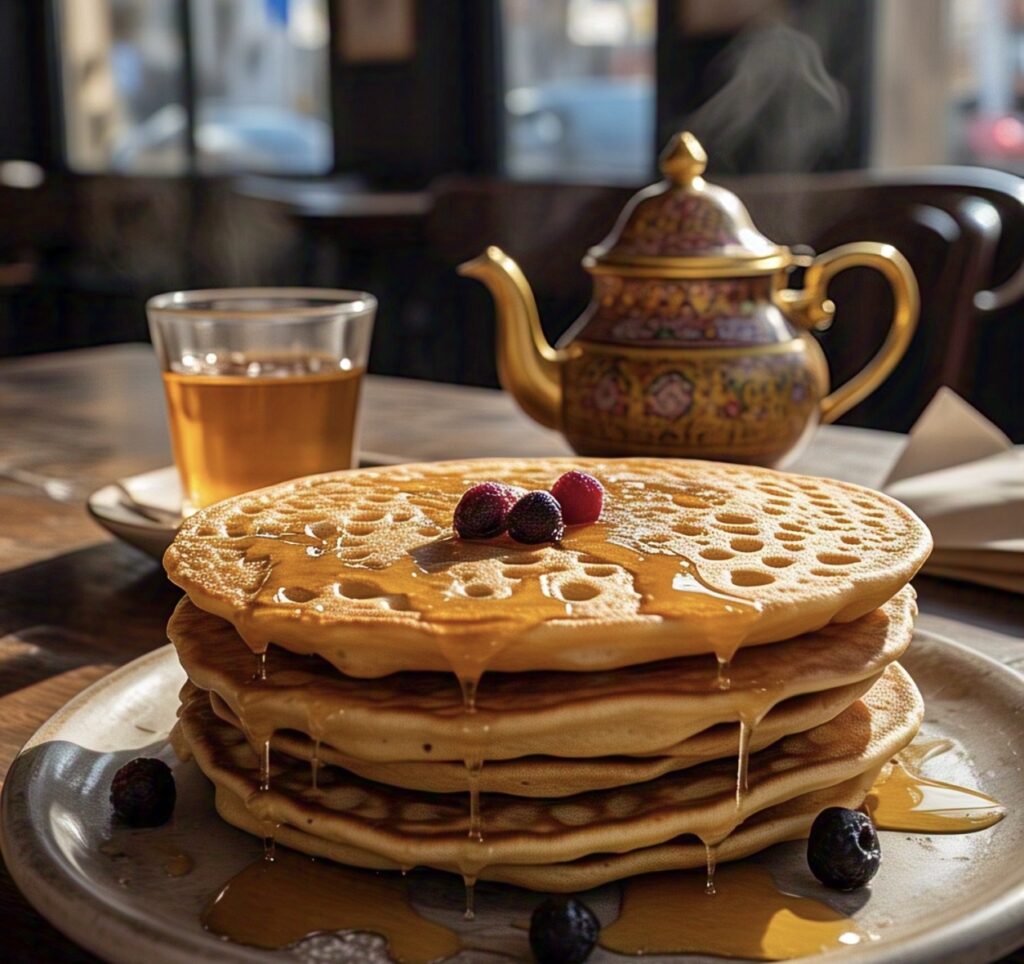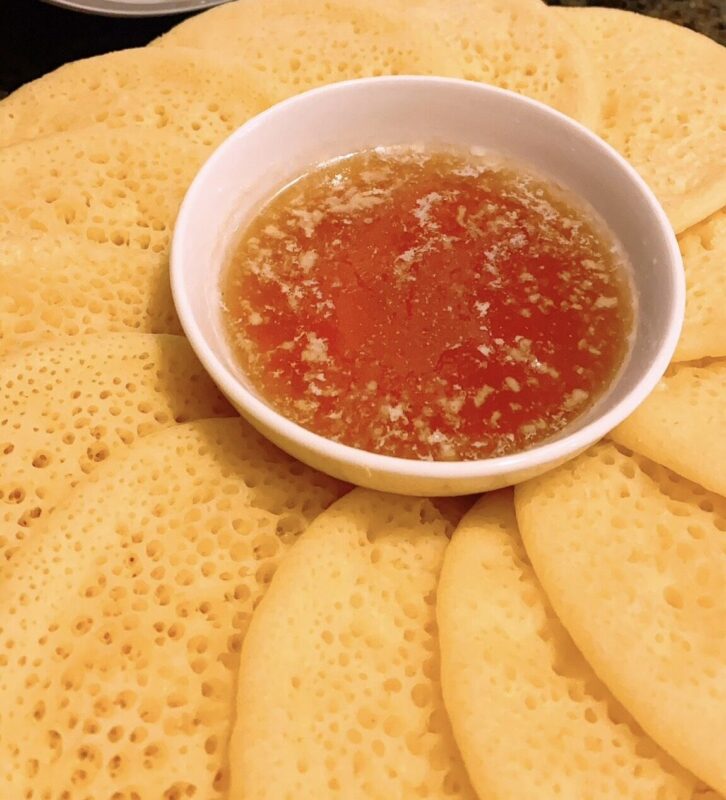Introduction
Baghrir, often referred to as “the Moroccan pancakes with a thousand holes,” is a beloved dish in Moroccan and North African cuisine. Known for its spongy texture and iconic hole-filled surface, baghrir stands out not only for its unique appearance but also for its rich cultural significance. These light and airy pancakes are traditionally enjoyed with a drizzle of honey and melted butter, creating a perfect balance of sweetness and texture.
Baghrir is a staple at Moroccan breakfast tables and is particularly popular during Ramadan and festive gatherings. Its soft, porous texture absorbs syrups and sauces effortlessly, making it a comforting and versatile dish. In this guide, we’ll explore the history, ingredients, and step-by-step process to make baghrir, along with tips for achieving perfect results and creative serving ideas.
Table of Contents
The History and Significance of Baghrir
Baghrir is more than just a pancake—it’s a culinary tradition that carries the flavors and stories of North Africa. Understanding the history of baghrir gives us a deeper appreciation of this beloved dish and its place in Moroccan culture.
1. A Staple in Moroccan Breakfast
In Moroccan households, breakfast isn’t complete without a plate of warm, freshly made baghrir. These pancakes are often enjoyed with a generous drizzle of honey, a pat of melted butter, or even a splash of orange blossom water.
Common Pairings:
- Served alongside Moroccan mint tea, a staple that complements the sweet, buttery richness of baghrir.
- Paired with amlou (a blend of almonds, honey, and argan oil) for an extra indulgent treat.
- Enjoyed with jams, nut spreads, or simply plain, letting the natural flavor of semolina shine through.
Daily Ritual:
Baghrir is often prepared in the morning, filling the kitchen with the comforting aroma of yeast and warm semolina. It’s a moment of togetherness, with family members gathering around to enjoy breakfast and share stories.
2. Symbolism of the Thousand Holes
The distinctive “thousand holes” that form on the surface of baghrir as it cooks are not just for show—they’re a hallmark of a well-made baghrir. These holes symbolize prosperity and abundance, making baghrir a fitting dish for celebrations and special occasions.
Culinary Science Behind the Holes:
- The bubbles form due to the combination of yeast and baking powder, which release gases during cooking.
- The unique batter, which is slightly thinner than traditional pancake batter, allows for the bubbling and creates the characteristic spongy texture.
Cultural Symbolism:
- Baghrir is often served during Ramadan, Eid, and other festive events, where the many holes are said to symbolize blessings and good fortune.
- Sharing baghrir during these times is a gesture of generosity and hospitality, embodying the communal spirit of Moroccan culture.
3. Regional Variations and Adaptations
While the classic baghrir is made with semolina, water, and yeast, regional adaptations can include different flours or flavorings.
Common Variations:
- baghrir might be flavored with a hint of vanilla or orange blossom water.
- Some versions incorporate a blend of semolina and all-purpose flour for a slightly different texture.
- Sweeteners can vary too—some use sugar, while others rely on the natural sweetness of honey drizzled on top.
Adaptations Beyond Morocco:
- Across the Maghreb, baghrir is celebrated and customized to local tastes, showing the flexibility and enduring appeal of this dish.
- Even beyond North Africa, baghrir has inspired cooks around the world to experiment with toppings like fresh fruit, chocolate spreads, or spiced syrups.
Baghrir’s rich history and cultural significance make it a dish worth celebrating, whether you’re indulging in a leisurely breakfast or marking a special occasion. Its tender, sponge-like texture and honeycomb appearance are a testament to the culinary artistry and hospitality that are central to Moroccan culture.
Essential Ingredients
Making baghrir requires just a handful of simple ingredients that come together to create its iconic spongy texture and delicate flavor.
Ingredients
- Semolina: Semolina flour is the primary ingredient in baghrir and gives it its characteristic texture. Use fine semolina for the best results, as it creates a smooth batter and ensures the formation of the “thousand holes.”
- All-Purpose Flour (Optional): While traditional baghrir is made entirely with semolina, some recipes use a small amount of all-purpose flour (about ¼ cup) to lighten the texture.
- Water: Lukewarm water is used to hydrate the batter and activate the yeast. It’s important to avoid hot water, as it can kill the yeast.
- Yeast: Yeast is essential for helping the batter rise and creating the bubbles that form the holes during cooking. Active dry yeast or instant yeast works well for this recipe.
- Baking Powder: Baking powder is added alongside yeast to enhance the bubbling effect and ensure the batter produces a spongy texture.
- Salt: A pinch of salt balances the flavor and enhances the overall taste.
- Sugar: A small amount of sugar feeds the yeast and adds a subtle sweetness to the pancakes. Traditional recipes use 1-2 teaspoons, but you can adjust to your taste.

Optional Add-Ins
- Milk or Buttermilk: Replacing part of the water with milk or buttermilk adds richness and a hint of creaminess to the batter.
- Orange Blossom Water: A splash of orange blossom water imparts a subtle floral aroma, giving the baghrir an extra layer of flavor.
- Vanilla Extract: Some variations include a touch of vanilla for a sweet, aromatic twist.
- Eggs: While not part of traditional baghrir recipes, some modern adaptations add an egg to enhance the batter’s binding and softness.
Proportions for a Classic Baghrir Recipe
Here’s a typical ratio for making baghrir:
- 2 cups fine semolina
- 2 ½ cups lukewarm water
- 1 teaspoon active dry yeast
- 1 teaspoon baking powder
- 1 teaspoon sugar
- ¼ teaspoon salt
Tips for Perfect Baghrir Ingredients
- Use Fresh Yeast: Ensure your yeast is fresh and active to achieve the desired rise and bubbling in the batter.
- Fine Semolina Matters: Coarser semolina can lead to a gritty texture, so opt for fine semolina for smooth pancakes.
- Balance the Liquid: The batter should be thinner than traditional pancake batter, almost pourable but not watery.
With these ingredients in hand, you’re ready to start making your own baghrir!
How to Make Baghrir (Step-by-Step Guide)
Baghrir is surprisingly simple to make once you master the technique. This step-by-step guide ensures that you’ll achieve perfectly spongy pancakes with their signature “thousand holes” every time.
Ingredients
- 2 cups fine semolina
- 2 ½ cups lukewarm water
- 1 teaspoon active dry yeast
- 1 teaspoon baking powder
- 1 teaspoon sugar
- ¼ teaspoon salt
Instructions
Step 1: Prepare the Batter
- In a blender or large mixing bowl, combine the fine semolina, sugar, salt, and baking powder.
- Dissolve the yeast in 2 ½ cups of lukewarm water. Let it sit for 1-2 minutes until slightly frothy.
- Gradually pour the water-yeast mixture into the dry ingredients while blending or whisking. Blend for about 2-3 minutes, or whisk thoroughly until the batter is smooth and lump-free.
Step 2: Rest the Batter
- Pour the batter into a bowl, cover it with a clean kitchen towel or plastic wrap, and let it rest for 30-45 minutes in a warm place.
- During this time, the yeast will activate, and you’ll notice bubbles forming on the surface of the batter. This is a good sign that your baghrir will form their signature holes.
Step 3: Preheat the Pan
- Heat a non-stick skillet or crepe pan over medium heat. There’s no need to grease the pan as traditional baghrir is cooked without oil or butter.
- To test the heat, sprinkle a few drops of water on the pan. If they sizzle and evaporate, the pan is ready.
Step 4: Cook the Baghrir
- Stir the batter gently, then pour a ladleful (about ¼ cup) onto the center of the hot pan.
- Let the batter spread naturally into a round pancake.
- Cook on medium heat until the surface is covered with holes and the edges are set. This usually takes about 1-2 minutes. Do not flip the baghrir—they are cooked on one side only.
- Remove from the pan and transfer to a clean kitchen towel. Cover to keep warm.
Step 5: Repeat
- Continue cooking the remaining batter, stirring occasionally to prevent separation.
- Stack the cooked baghrir on a plate, placing a clean towel or parchment paper between each pancake to avoid sticking.

Serving Baghrir
Baghrir is best served warm with a drizzle of melted butter and honey. You can also pair it with:
- Amlou: A Moroccan almond, argan oil, and honey spread.
- Jams or Preserves: Fruity flavors like apricot or orange marmalade.
- Savory Toppings: Cheese spreads, roasted vegetables, or even eggs for a modern twist.
Tips for Perfect Baghrir and Creative Serving Ideas
Mastering baghrir requires attention to detail, from the batter consistency to the cooking technique. With these tips and serving ideas, you can elevate your baghrir from a simple pancake to a standout dish.
Tips for Perfect Baghrir
- Use Fine Semolina: The texture of baghrir depends on fine semolina. If you only have coarse semolina, blend it in a food processor or blender until smooth.
- Check Your Yeast: Ensure your yeast is fresh and active. If it doesn’t froth when dissolved in water, replace it with a new batch to ensure the batter rises properly.
- Blend the Batter: For smooth, lump-free baghrir, blend the batter in a blender or whisk it thoroughly. This step ensures the even formation of bubbles.
- Proper Resting Time: Allow the batter to rest for at least 30 minutes in a warm spot. This activates the yeast and produces the airy texture with “thousand holes.”
- Avoid Greasing the Pan: Traditional baghrir is cooked on a dry, non-stick pan. Greasing the pan can interfere with the formation of bubbles.
- Do Not Flip: Baghrir is cooked on one side only. Flipping will disrupt its unique texture and appearance.
- Control the Heat: Use medium heat to ensure even cooking. Too high, and the pancakes may burn; too low, and the holes may not form properly.
- Stir Occasionally: Stir the batter gently before pouring each batch to ensure the ingredients remain well-mixed.
Creative Serving Ideas
Baghrir is incredibly versatile and pairs well with a variety of sweet and savory toppings. Here are some creative ways to serve it:
1- Classic Sweet Serving
- Honey and Butter: The traditional way to serve baghrir is by drizzling melted butter and honey over the warm pancakes. This simple pairing highlights their spongy texture and delicate flavor.
- Amlou Spread: Spread a layer of amlou (Moroccan almond, argan oil, and honey spread) on baghrir for a rich and nutty flavor.
- Fresh Fruits: Top with sliced bananas, berries, or mangoes for a fresh and vibrant touch.
- Nutella or Chocolate Sauce: Add a drizzle of Nutella or melted chocolate for a decadent dessert option.

- Moroccan Mint Tea Recipe – A traditional drink that pairs well with Baghrir
2- Modern Sweet Twists
- Citrus Infusion: Combine honey with a splash of orange blossom water or lemon zest for a zesty upgrade.
- Whipped Cream and Berries: Layer whipped cream and fresh strawberries or blueberries for a crepe-style dessert.
- Caramelized Apples: Sauté apple slices with brown sugar and cinnamon, then layer them over baghrir.
3-Savory Variations
- Cream Cheese and Smoked Salmon: Spread herb-infused cream cheese and top with smoked salmon and capers for a luxurious brunch option.
- Eggs and Vegetables: Serve baghrir with scrambled eggs, sautéed spinach, or roasted peppers for a hearty meal.
- Cheese and Herbs: Top with crumbled feta or goat cheese, fresh herbs, and a drizzle of olive oil for a Mediterranean-inspired dish.

4- Baghrir as a Base
- Mini Baghrir Snacks: Cook small, bite-sized baghrir and top each with a unique topping for an appetizer platter.
- Layered Baghrir Cake: Stack baghrir with layers of cream and fruit for a no-bake Moroccan-inspired dessert.
Storage and Reheating Tips
- Storing Leftovers: Store cooked baghrir in an airtight container in the refrigerator for up to 3 days.
- Freezing: Place parchment paper between each pancake, then freeze in a sealed bag for up to 1 month.
- Reheating: Warm baghrir in a non-stick pan or microwave before serving. Avoid reheating in the oven, as it can dry them out.
By following these tips and experimenting with creative serving ideas, you can turn baghrir into a show-stopping dish for any meal or occasion
FAQs About Baghrir
Why didn’t my baghrir form holes?
The most common reasons baghrir doesn’t develop holes include:
- Inactive yeast: Ensure your yeast is fresh and properly activated before mixing the batter.
- Improper batter consistency: If the batter is too thick, the bubbles won’t form properly. Add a little more water to thin it.
- Heat issues: The pan may be too hot or too cold. Medium heat works best to cook the baghrir evenly and encourage bubbles to form.
Can I make baghrir with gluten-free flour?
Yes! Substitute fine semolina with a gluten-free flour blend or fine rice flour. While the texture may differ slightly, the result will still be soft and spongy.
How do I store leftover baghrir?
- Store baghrir in an airtight container in the refrigerator for up to 3 days.
- For longer storage, freeze baghrir with parchment paper between each pancake to prevent sticking. Thaw and reheat before serving.
Do I need a special pan to make baghrir?
No, a non-stick skillet or crepe pan works perfectly. Ensure the pan is clean and dry before pouring the batter to prevent sticking.
Can I make baghrir without a blender?
Yes! If you don’t have a blender, whisk the batter thoroughly until smooth. Sifting the dry ingredients first helps avoid lumps.
Is baghrir always sweet?
While traditionally served sweet with honey and butter, baghrir can also be enjoyed as a savory dish. Pair it with cheese, smoked salmon, or sautéed vegetables for a modern twist.
Baghrir (Moroccan Semolina Pancakes)
Equipment
- Blender
- Nonstick skillet or crepe pan
- Ladle
Ingredients
For the Baghrir Batter
- 1 cup fine semolina
- ½ cup all-purpose flour
- 1 tbsp sugar
- ½ tsp salt
- 1 tbsp baking powder
- 1 tsp instant yeast
- 2 cups warm water Not hot.
To Serve
- butter and honey mixture Melted together for drizzling.
Instructions
- Add semolina, flour, sugar, salt, baking powder, yeast, and warm water to a blender. Blend for 1–2 minutes until completely smooth.
- Let the batter rest for 10–15 minutes at room temperature until slightly foamy.
- Heat a nonstick pan over medium heat. Do not grease the pan. Stir the batter gently and pour a small ladle into the pan to form a circle (like a pancake).
- Cook on one side only. Bubbles will appear all over the surface—this is the signature look of baghrir. Do not flip. Once dry on top, remove from pan.
- Repeat with remaining batter, stirring gently before each pour. Let pancakes cool slightly on a clean towel.
- Serve warm with melted butter and honey drizzle.
Notes
Conclusion
Baghrir, the iconic Moroccan pancake with a thousand holes, is a dish that combines tradition, flavor, and versatility. Whether you’re enjoying it for breakfast with honey and butter, as a dessert with Nutella and fruits, or even as a savory base for brunch creations, baghrir is sure to delight your taste buds.
This simple yet unique dish reflects the warmth and hospitality of Moroccan culture, making it a favorite at family tables and special celebrations alike. With this guide, you now have all the tools, tips, and creative ideas you need to make perfect baghrir at home.
So why not give it a try? Gather your ingredients, heat your skillet, and experience the joy of baghrir today. Your kitchen will be filled with the irresistible aroma of this timeless Moroccan treat!
For more Recipes to Try
Looking for citrus-inspired desserts? Check out these recipes:
- Citrus Mandarin Orange Cake Recipe: Discover vibrant orange dessert that pairs citrus flavors with a moist and tender cake base.
- Chocolate Orange Cake Recipe: Explore a richer take on orange desserts by combining chocolate and orange for a sophisticated treat.


